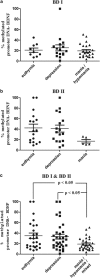Selective DNA methylation of BDNF promoter in bipolar disorder: differences among patients with BDI and BDII
- PMID: 22353757
- PMCID: PMC3358733
- DOI: 10.1038/npp.2012.10
Selective DNA methylation of BDNF promoter in bipolar disorder: differences among patients with BDI and BDII
Abstract
The etiology of bipolar disorder (BD) is still poorly understood, involving genetic and epigenetic mechanisms as well as environmental contributions. This study aimed to investigate the degree of DNA methylation at the promoter region of the brain-derived neurotrophic factor (BDNF) gene, as one of the candidate genes associated with major psychoses, in peripheral blood mononuclear cells isolated from 94 patients with BD (BD I=49, BD II=45) and 52 healthy controls. A significant BDNF gene expression downregulation was observed in BD II 0.53±0.11%; P<0.05), but not in BD I (1.13±0.19%) patients compared with controls (CONT: 1±0.2%). Consistently, an hypermethylation of the BDNF promoter region was specifically found in BD II patients (CONT: 24.0±2.1%; BDI: 20.4±1.7%; BDII: 33.3±3.5%, P<0.05). Of note, higher levels of DNA methylation were observed in BD subjects on pharmacological treatment with mood stabilizers plus antidepressants (34.6±4.2%, predominantly BD II) compared with those exclusively on mood-stabilizing agents (21.7±1.8%; P<0.01, predominantly BD I). Moreover, among the different pharmacological therapies, lithium (20.1±3.8%, P<0.05) and valproate (23.6±2.9%, P<0.05) were associated with a significant reduction of DNA methylation compared with other drugs (35.6±4.6%). Present findings suggest selective changes in DNA methylation of BDNF promoter in subjects with BD type II and highlight the importance of epigenetic factors in mediating the onset and/or susceptibility to BD, providing new insight into the mechanisms of gene expression. Moreover, they shed light on possible mechanisms of action of mood-stabilizing compounds vs antidepressants in the treatment of BD, pointing out that BDNF regulation might be a key target for their effects.
Figures








Similar articles
-
Epigenetic modulation of BDNF gene: differences in DNA methylation between unipolar and bipolar patients.J Affect Disord. 2014 Sep;166:330-3. doi: 10.1016/j.jad.2014.05.020. Epub 2014 May 23. J Affect Disord. 2014. PMID: 25012449
-
Regulation of gene transcription in bipolar disorders: Role of DNA methylation in the relationship between prodynorphin and brain derived neurotrophic factor.Prog Neuropsychopharmacol Biol Psychiatry. 2018 Mar 2;82:314-321. doi: 10.1016/j.pnpbp.2017.08.011. Epub 2017 Aug 19. Prog Neuropsychopharmacol Biol Psychiatry. 2018. PMID: 28830794 Free PMC article.
-
Brain-derived neurotrophic factor (BDNF)-epigenetic regulation in unipolar and bipolar affective disorder.J Affect Disord. 2014 Oct;168:399-406. doi: 10.1016/j.jad.2014.07.022. Epub 2014 Jul 19. J Affect Disord. 2014. PMID: 25106037
-
The impact of BDNF Val66Met polymorphism on cognition in Bipolar Disorder: A review: Special Section on "Translational and Neuroscience Studies in Affective Disorders" Section Editor, Maria Nobile MD, PhD. This Section of JAD focuses on the relevance of translational and neuroscience studies in providing a better understanding of the neural basis of affective disorders. The main aim is to briefly summaries relevant research findings in clinical neuroscience with particular regards to specific innovative topics in mood and anxiety disorders.J Affect Disord. 2019 Jan 15;243:552-558. doi: 10.1016/j.jad.2018.07.054. Epub 2018 Jul 24. J Affect Disord. 2019. PMID: 30078664 Review.
-
Response to lithium in bipolar disorder: clinical and genetic findings.ACS Chem Neurosci. 2014 Jun 18;5(6):413-21. doi: 10.1021/cn5000277. Epub 2014 Mar 25. ACS Chem Neurosci. 2014. PMID: 24625017 Free PMC article. Review.
Cited by
-
A DNA methylation signature discriminates between excellent and non-response to lithium in patients with bipolar disorder type 1.Sci Rep. 2020 Jul 22;10(1):12239. doi: 10.1038/s41598-020-69073-0. Sci Rep. 2020. PMID: 32699220 Free PMC article.
-
Psychotropic drug-induced genetic-epigenetic modulation of CRTC1 gene is associated with early weight gain in a prospective study of psychiatric patients.Clin Epigenetics. 2019 Dec 26;11(1):198. doi: 10.1186/s13148-019-0792-0. Clin Epigenetics. 2019. PMID: 31878957 Free PMC article.
-
Recent advances in the understanding and management of bipolar disorder in adults.F1000Res. 2017 Nov 21;6:2033. doi: 10.12688/f1000research.12329.1. eCollection 2017. F1000Res. 2017. PMID: 29188027 Free PMC article. Review.
-
Epigenetic perspective on the role of brain-derived neurotrophic factor in burnout.Transl Psychiatry. 2020 Oct 19;10(1):354. doi: 10.1038/s41398-020-01037-4. Transl Psychiatry. 2020. PMID: 33077716 Free PMC article.
-
The Relationship between DNA Methylation and Antidepressant Medications: A Systematic Review.Int J Mol Sci. 2020 Jan 28;21(3):826. doi: 10.3390/ijms21030826. Int J Mol Sci. 2020. PMID: 32012861 Free PMC article.
References
-
- Abdolmaleky HM, Thiagalingam S, Wilcox M. Genetics and epigenetics in major psychiatric disorders: dilemmas, achievements, applications, and future scope. Am J Pharmacogenomics. 2005;5:149–160. - PubMed
-
- Arosio B, Viazzoli C, Mastronardi L, Bilotta C, Vergani C, Bergamaschini L. Adenosine A2A receptor expression in peripheral blood mononuclear cells of patients with mild cognitive impairment. J Alzheimers Dis. 2010;20:991–996. - PubMed
-
- Brunoni AR, Lopes M, Fregni F. A systematic review and meta-analysis of clinical studies on major depression and BDNF levels: implications for the role of neuroplasticity in depression. Int J Neuropsychopharmacol. 2008;11:1169–1180. - PubMed

